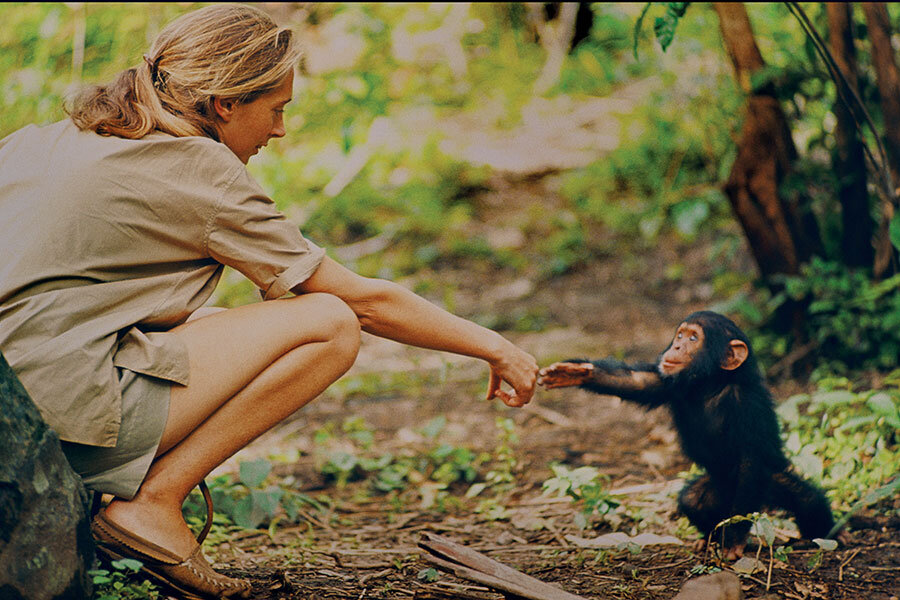Documentary brings Goodall’s story to vivid life in ‘Jane’
Loading...
Jane Goodall, the great English primatologist who has spent much of her life studying chimpanzees in their natural habitat, grew up as a girl wishing she could be “as close to animals as I could.” She says she “dreamt as a boy,” and, lo and behold, not long after she began her research in 1960 in Tanzania under the mentorship of the Kenyan-born paleontologist Louis Leakey, she discovered that “I was actually living my dream.”
Brett Morgen’s documentary “Jane” brings Goodall’s ineffable and incredible story to vivid life, starting with the aforementioned anecdotes as, now in her 80s and still seraphically beautiful, she recalls with an almost ethereal calm the extraordinariness of her days.
The film’s main reason for being was the 2014 discovery of a trove of more than 140 hours of previously unseen 16-millimeter footage from the 1960s, filmed mostly by her then-husband Hugo van Lawick under the auspices of National Geographic. We see Goodall almost from the beginning of her explorations – at first observing from afar, with binoculars, a chimpanzee community – and it’s as if we have stepped into a time machine. We are so used to seeing reenactments in documentaries of this sort that to see the real thing is both unnerving and exhilarating. We are up close and personal not only with Goodall but with the chimpanzees themselves, as they gradually learn to accept her presence in the wild.
“I was an intruder, and a strange one at that,” she says. “A strange white ape.” At first, because the chimpanzees were so standoffish with her, she felt that “I wasn’t really learning anything much.” Leakey, who was not part of her expedition on the ground, had hired her despite – or more likely, because of – her lack of academic credentials. She was 26 and too poor to attend a university, but she possessed Leakey’s prime prerequisites: “an open mind, a passion for knowledge, patience, and a love of animals.” (It was her mother, who initially accompanied her and for a time served as a nurse in the Tanzanian community, who inspired her surplus of self-esteem.)
Goodall’s big breakthrough came when she observed the senior male of the tribe – David Greybeard, she dubbed him – fashioning a twig to use as a tool for rooting out termites. Until then, it was assumed that toolmaking was exclusive to man. Her finding was at first disparaged by the almost exclusively male scientific community as nothing more than feminine wish fulfillment. Gradually, though, her findings were accepted. And, of course, it’s doubly wonderful in this film to see David Greybeard actually poking his twig into the ground and nibbling termites. Seeing is believing.
Leakey’s mission, as carried out by Goodall, was to chart the linkages between the great apes and early hominids, and some of the most moving sequences in the film depict Goodall’s wonderment at the evolutionary connectedness of ape and human. She talks about how she observed up close a giant chimpanzee and “saw a thinking, reasoning personality looking back.” When she and Van Lawick, living in Tanzania, have a child, whom they nickname “Grub,” her passage into motherhood is mysteriously enhanced by her intimate observations of Flo, the chimpanzee’s senior female, and her baby male.
But lest you think Goodall is some wide-eyed innocent, she makes it clear that, especially after her beloved chimpanzee community degenerated into bloody intertribal warfare, she could no longer sanction her pastoral preconceptions.
She had earlier remarked that “the more I learned, the more I realized that [the chimpanzees] were like us in so many ways.” She had to come to terms with the fact that she “had no idea of the brutality that they could show.” This, too, is what links us with the apes, and there’s an undercurrent of sorrow in her admission.
But she remains a champion of African apes through the Jane Goodall Institute as she battles their decimation through hunting and trapping. Who could have predicted that the gawky, lanky 26-year-old woman that we first see in “Jane” would end up spearheading the world’s longest continuous study of chimpanzees?
Well, as this film demonstrates, Jane Goodall herself could have predicted it. Grade: A (This movie is not rated.)







